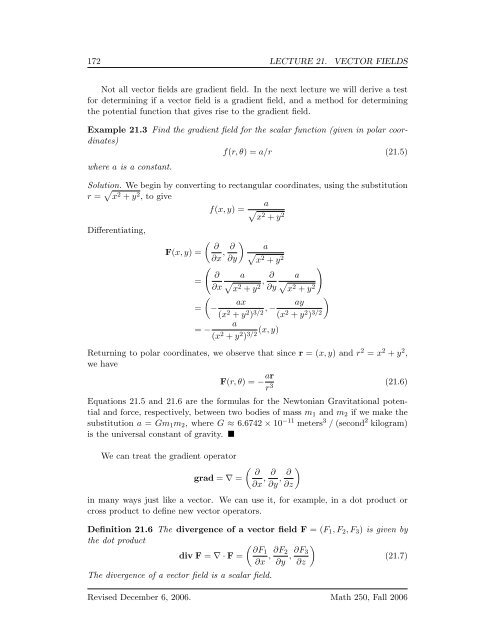Multivariate Calculus - Bruce E. Shapiro
Multivariate Calculus - Bruce E. Shapiro
Multivariate Calculus - Bruce E. Shapiro
You also want an ePaper? Increase the reach of your titles
YUMPU automatically turns print PDFs into web optimized ePapers that Google loves.
172 LECTURE 21. VECTOR FIELDS<br />
Not all vector fields are gradient field. In the next lecture we will derive a test<br />
for determining if a vector field is a gradient field, and a method for determining<br />
the potential function that gives rise to the gradient field.<br />
Example 21.3 Find the gradient field for the scalar function (given in polar coordinates)<br />
f(r, θ) = a/r (21.5)<br />
where a is a constant.<br />
Solution. We begin by converting to rectangular coordinates, using the substitution<br />
r = √ x 2 + y 2 , to give<br />
a<br />
f(x, y) = √<br />
x 2 + y 2<br />
Differentiating,<br />
( ∂<br />
F(x, y) =<br />
∂x , ∂ )<br />
a<br />
√<br />
∂y x 2 + y<br />
(<br />
2<br />
)<br />
∂ a<br />
= √<br />
∂x x 2 + y , ∂ a<br />
√ 2 ∂y x 2 + y 2<br />
(<br />
)<br />
ax<br />
= −<br />
(x 2 + y 2 ) 3/2 , − ay<br />
(x 2 + y 2 ) 3/2<br />
a<br />
= −<br />
(x 2 + y 2 (x, y)<br />
) 3/2<br />
Returning to polar coordinates, we observe that since r = (x, y) and r 2 = x 2 + y 2 ,<br />
we have<br />
F(r, θ) = − ar<br />
r 3 (21.6)<br />
Equations 21.5 and 21.6 are the formulas for the Newtonian Gravitational potential<br />
and force, respectively, between two bodies of mass m 1 and m 2 if we make the<br />
substitution a = Gm 1 m 2 , where G ≈ 6.6742 × 10 −11 meters 3 / (second 2 kilogram)<br />
is the universal constant of gravity. <br />
We can treat the gradient operator<br />
grad = ∇ =<br />
( ∂<br />
∂x , ∂ ∂y , ∂ )<br />
∂z<br />
in many ways just like a vector. We can use it, for example, in a dot product or<br />
cross product to define new vector operators.<br />
Definition 21.6 The divergence of a vector field F = (F 1 , F 2 , F 3 ) is given by<br />
the dot product<br />
( ∂F1<br />
div F = ∇ · F =<br />
∂x , ∂F 2<br />
∂y , ∂F )<br />
3<br />
(21.7)<br />
∂z<br />
The divergence of a vector field is a scalar field.<br />
Revised December 6, 2006. Math 250, Fall 2006
















